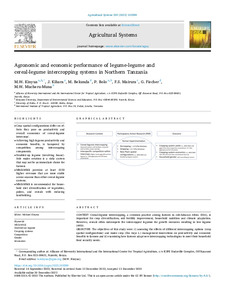| dc.contributor.author | Kinyua, M. |
| dc.contributor.author | Kihara, J. |
| dc.contributor.author | Bekunda, M. |
| dc.contributor.author | Bolo, P. |
| dc.contributor.author | Mairura, F.S. |
| dc.contributor.author | Fischer, G. |
| dc.contributor.author | Mucheru-Muna, M. |
| dc.date.accessioned | 2023-04-25T08:22:46Z |
| dc.date.available | 2023-04-25T08:22:46Z |
| dc.date.issued | 2023-02 |
| dc.identifier.citation | Kinyua, M., Kihara, J., Bekunda, M., Bolo, P., Mairura, F.S., Fischer, G. & Mucheru-Muna, M. (2023). Agronomic and economic performance of legume-legume and cereal-legume intercropping systems in Northern Tanzania. Agricultural Systems, 205: 103589, 1-13. |
| dc.identifier.issn | 0308-521X |
| dc.identifier.uri | https://hdl.handle.net/20.500.12478/8150 |
| dc.description.abstract | CONTEXT Cereal-legume intercropping, a common practice among farmers in sub-Saharan Africa (SSA), is important for crop diversification, soil fertility improvement, household nutrition and climate adaptation. However, cereals often outcompete the intercropped legumes for growth resources resulting in low legume yields. OBJECTIVE The objectives of this study were: i) assessing the effects of different intercropping options (crop spatial configurations) and maize crop (Zea mays L.) management innovations on productivity and economic benefits to farmers and ii) examining how farmers adapt new intercropping technologies to meet their household food security needs. METHODS The study was undertaken in six on-farm researcher-designed and managed trials in high and low rainfall agro-ecological zones of Babati District in Tanzania, during four cropping seasons (2018–2021). The cropping systems tested included a sole maize system rotated with a legume-legume intercrop (Doubled-up legume), an innovation involving two maize rows intercropped with two legume species (Mbili-Mbili), maize-legume intercrop both with and without de-topping, maize-legume intercrop (2 maize plants at 50 cm intra-space, de-topped), maize-legume system (maize with vertical leaf architecture) and a farmer practice. The Mbili-Mbili technology adaptation assessment was conducted on 225 farmers during the 2021 cropping season. RESULTS AND CONCLUSIONS Overall, maize grain yields increased by up to 56% in improved compared to farmer intercropping practices (P ≤ 0.05). There were no significant differences in maize grain yield among the improved practices. Significantly higher pigeonpea (Cajanus cajan) yields of between 71% and 113% in 2020 and between 65% and 140% in 2021 were observed under Doubled-up legume and between 63% and 124% under local farmer practices in 2020 than in the improved cereal-legume practices. Across the study period, net revenues of sole maize and Doubled-up legume rotations were both the highest and lowest relative to other intercropping options, depending on the starting phase (US$ 653 sole maize and US$ 326 legume phase starting). These were also associated with the highest variances indicating instability. Mbili-Mbili intercropping system had not only high net revenue i.e., a mean of US$623 per hectare, but also more stable. Farmers perceived that Mbili-Mbili increased food security and 96% were willing to implement the system without project support. SIGNIFICANCE Mbili-Mbili is recommended for adoption by farmers because of its potential economic benefits, food security and resilience in the current unpredictable weather and climate patterns. |
| dc.description.sponsorship | United States Agency for International Development |
| dc.format.extent | 1-13 |
| dc.language.iso | en |
| dc.subject | Legumes |
| dc.subject | Cropping Systems |
| dc.subject | Gender |
| dc.subject | Economics |
| dc.subject | Tanzania |
| dc.subject | Intercropping |
| dc.subject | Farmers |
| dc.subject | Households |
| dc.subject | Nutrition |
| dc.subject | Maize |
| dc.subject | Soil Fertility |
| dc.subject | Innovation |
| dc.subject | Technology |
| dc.title | Agronomic and economic performance of legume-legume and cereal-legume intercropping systems in Northern Tanzania |
| dc.type | Journal Article |
| cg.contributor.crp | Maize |
| cg.contributor.affiliation | Alliance of Bioversity International and International Center for Tropical Agriculture |
| cg.contributor.affiliation | Kenyatta University |
| cg.contributor.affiliation | University of Embu |
| cg.contributor.affiliation | International Institute of Tropical Agriculture |
| cg.coverage.region | Africa |
| cg.coverage.region | East Africa |
| cg.coverage.country | Tanzania |
| cg.researchtheme | Natural Resource Management |
| cg.researchtheme | Plant Production and Health |
| cg.identifier.bibtexciteid | KINYUA:2023 |
| cg.isijournal | ISI Journal |
| cg.authorship.types | CGIAR and developing country institute |
| cg.iitasubject | Agronomy |
| cg.iitasubject | Crop Systems |
| cg.iitasubject | Food Security |
| cg.iitasubject | Gender |
| cg.iitasubject | Grain Legumes |
| cg.iitasubject | Plant Breeding |
| cg.iitasubject | Plant Production |
| cg.iitasubject | Soil Fertility |
| cg.journal | Agricultural Systems |
| cg.notes | Open Access Article; Published online: 20 Dec 2022 |
| cg.accessibilitystatus | Open Access |
| cg.reviewstatus | Peer Review |
| cg.usagerightslicense | Creative Commons Attribution 4.0 (CC BY 0.0) |
| cg.targetaudience | Scientists |
| cg.identifier.doi | https://dx.doi.org/10.1016/j.agsy.2022.103589 |
| cg.iitaauthor.identifier | Mateete Bekunda: 0000-0001-7297-9383 |
| cg.iitaauthor.identifier | Gundula Fischer: 0000-0002-7658-786X |
| cg.futureupdate.required | No |
| cg.identifier.issue | 103589 |
| cg.identifier.volume | 205 |

